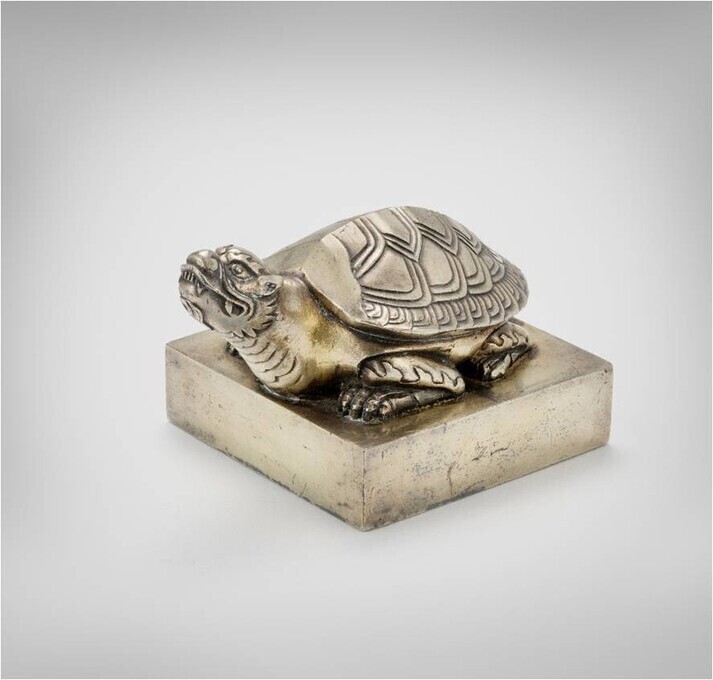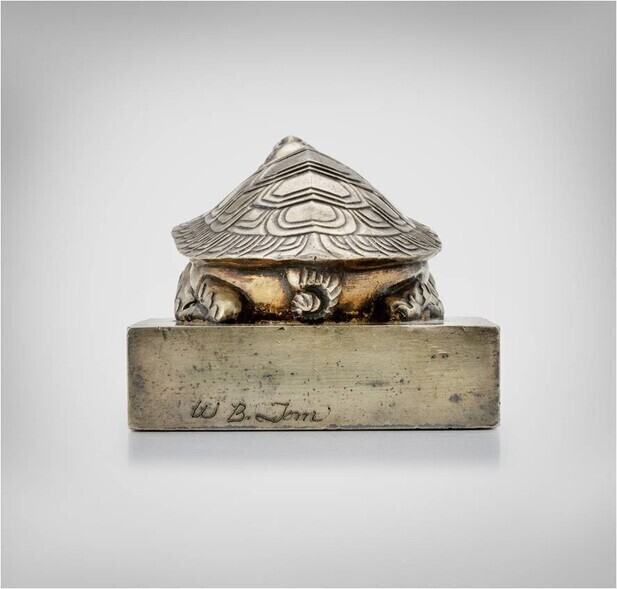hankyoreh
Links to other country sites 다른 나라 사이트 링크
Royal seal of Korean Empire returns home from US

On the back of the great seal of the Korean Empire, representing the power of the emperor himself, are engraved the Roman letters "WB. Tom" — the name of a Westerner.
That was a mournful discovery for researchers at South Korea's Cultural Heritage Administration (CHA) when the seal was donated by a Korean-American businessman named Lee Dae-su in December 2019.
The great seal (called Daegunjubo) was used by Emperor Gojong while conducting the business of the state. Gojong reigned as king of Joseon (an indigenous kingdom that occupied the Korean Peninsula) from 1864 to 1897 and then as emperor from 1897 to 1907.
According to various records from the reign of Gojong, Daegunjubo was one of three great seals created on the orders of Gojong in 1882. It served as the great seal of state, affixed to diplomatic and administrative documents, until 1897, when the Empire of Korea was proclaimed.

But after being taken to the US, the seal was treated as a mere keepsake, with one collector even having his name engraved on it.
Now Daegunjubo has emerged from obscurity to gain recognition as an official treasure.
The CHA announced Monday that Daegunjubo and three other state seals returned from Japan after Korea's liberation from colonial rule in 1945 (Jegojibo, Chikmyeongjibo, and Daewonsubo) will all be designated as treasures.
Measuring 3.1 inches by 5 inches, Daegunjubo is made of gilded silver. A handle in the shape of a turtle is attached to the body of the seal.
The characters 大君主 (pronounced "Daegunju"), meaning "great prince," are engraved on the seal, testifying to Joseon's struggle to free itself from the suzerainty of China and become a fully sovereign state. The seal was made in the same year that Joseon signed a treaty with the US, in 1882.
The other three state seals were created for use in appointing officials and delivering imperial decrees. Those seals were handed over to the Imperial Household Agency, which manages the affairs of Japan's royal family, in March 1911, shortly after Korea's annexation by Japan. They were transferred to the National Museum of Korea on Aug. 15, 1946, by the US military authorities.
Following the announcement of the plan to designate the four state seals as official treasures, the CHA will canvass opinions from various groups for 30 days and then reach a final decision in a meeting of its cultural heritage committee.
By Roh Hyung-suk, senior staff writer
Please direct comments or questions to [english@hani.co.kr]

Editorial・opinion
![[Column] Season 2 of special prosecutor probe may be coming to Korea soon [Column] Season 2 of special prosecutor probe may be coming to Korea soon](https://flexible.img.hani.co.kr/flexible/normal/500/300/imgdb/original/2024/0426/3317141030699447.jpg) [Column] Season 2 of special prosecutor probe may be coming to Korea soon
[Column] Season 2 of special prosecutor probe may be coming to Korea soon![[Column] Park Geun-hye déjà vu in Yoon Suk-yeol [Column] Park Geun-hye déjà vu in Yoon Suk-yeol](https://flexible.img.hani.co.kr/flexible/normal/500/300/imgdb/original/2024/0424/651713945113788.jpg) [Column] Park Geun-hye déjà vu in Yoon Suk-yeol
[Column] Park Geun-hye déjà vu in Yoon Suk-yeol- [Editorial] New weight of N. Korea’s nuclear threats makes dialogue all the more urgent
- [Guest essay] The real reason Korea’s new right wants to dub Rhee a founding father
- [Column] ‘Choson’: Is it time we start referring to N. Korea in its own terms?
- [Editorial] Japan’s rewriting of history with Korea has gone too far
- [Column] The president’s questionable capacity for dialogue
- [Column] Are chaebol firms just pizza pies for families to divvy up as they please?
- [Column] Has Korea, too, crossed the Rubicon on China?
- [Correspondent’s column] In Japan’s alliance with US, echoes of its past alliances with UK
Most viewed articles
- 1After election rout, Yoon’s left with 3 choices for dealing with the opposition
- 2AI is catching up with humans at a ‘shocking’ rate
- 3South Korea officially an aged society just 17 years after becoming aging society
- 4Noting shared ‘values,’ Korea hints at passport-free travel with Japan
- 51 in 5 unwed Korean women want child-free life, study shows
- 6Is Japan about to snatch control of Line messenger from Korea’s Naver?
- 7Why Kim Jong-un is scrapping the term ‘Day of the Sun’ and toning down fanfare for predecessors
- 8Two factors that’ll decide if Korea’s economy keeps on its upward trend
- 9[Column] ‘Choson’: Is it time we start referring to N. Korea in its own terms?
- 10Korea’s 1.3% growth in Q1 signals ‘textbook’ return to growth, says government